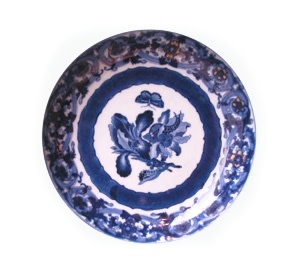Painted in rich blue and white, heightened in gilding, the centre with two caterpillars crawling across a spray of exotic flowers and a butterfly hovering over them, flowers and insects painted with exceptional detail and very well-shaded, within a decorative dark blue band and an elaborate European style strapwork border, on both of which gilding is still visible. The reverse painted at the rim with a trellis-work diaper, the rim with a brown wash.
Literature
This design, which is also known in overglaze coloured enamels, is copied from a painting by the Dutch botanist Maria Sybille Merian (1646 1717), who travelled extensively in the Dutch West Indies. It would probably have been made for the Dutch Market. One such famille rose dish is in the Victoria & Albert Museum, London, a Julia C. Gulland Gift (inv. 583-1907). See also Jacquemart & Le Blant, Histoire de la Porcelaine, pl. XI. For a vase illustrated with a very similar design and a Famille Rose example of the same design see Howard & Ayers, China for the West, pp 304 5. There are similar plates in the Victoria and Albert Museum and in the Philadelphia Museum of Art (China Trade Porcelain, Cat 33)
See 'Art & Antiques' issue for an article by Charlotte Jacob-Hanson, summarized below.
Maria Sibylla Merian became interested at an early age in drawing insects and flowers both from the life and by copying motifs from the Archetypa of Jacob Hoefnagel and the Historiae Naturalis de Insectis of Joannes Jonstonus. After moving to Nuremberg with her husband in 1670, Merian sold her own prepared ground paints and gave lessons in embroidery to the city?s patrician daughters. She published three highly successful Blumenbucher of embroidery motifs. These are now very rare, as they were handled at the time like knitting patterns.
With the help of her pupils Merian gathered caterpillars from neighbouring gardens and over five years observed the stages of their development. She published her observation on the four stages of metamorphosis - eggs, larva, pupa, imago - in 2 Raupenbucher: 'caterpillar books'; where she would show all four stages in one picture. This was quite revolutionary. The view had been held that caterpillars developed form decaying vegetable matter and the Dutch artist Joannes Goodaert omitted the egg stage in his drawings. She also gave the insects in her paintings precedence over the plants.
She moved to a community of Labadists in the Netherlands in 1685 without her husband, where she continued her studies by collecting caterpillars from the Frisian moors. Her 'Studienbuch' of the time contained a re-copying if her Raupenbuch notes and life-sized insect studies. She moved to Amsterdam with her daughter in 1691, where she became active in a flourishing botanical circle and was increasingly beset by private commissions, interst having been awakened by the stories of those involved with the East and West India Companies. In 1699 she went to Surinam with her daughter to study the exotic insects she had first learnt about from the missionaries at the Labadist colony. On her return she published a book containing 60 plates, and several editions of this and of her Raupenbucher continued to be published in French, Latin and Dutch throughout her lifetime.
She had an influence on botanical illustration throughout the 18th century. Merian-influenced designs appeared on faience made at factories in Hochst and Strasbourg and on Chine de Commande, where designs integrate several different Merian plates. However, we must be careful not to attribute any piece with a botanical theme to her designs.
See Jorg, Chinese Ceramics in the Collection of the Rijksmuseum (Amsterdam 1997) where he states that 'Merian usually only painted one species at a time. It is therefore likely that some other European flower print would have been the inspiration for the porcelain painter.' See pl.334 p.287 for a coloured example.

